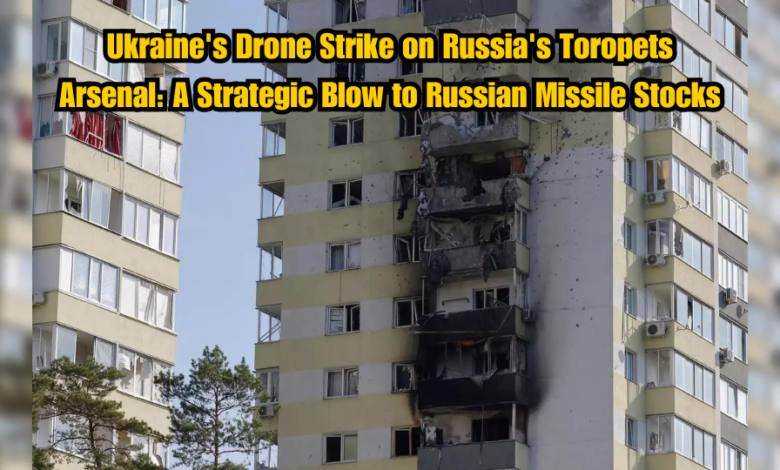Ukraine’s Drone Strike on Russia’s Toropets Arsenal: A Strategic Blow to Russian Missile Stocks

In a bold move on Tuesday, Ukraine launched a large-scale drone strike on Russia’s Toropets, a town known for hosting a key military arsenal. The operation, involving over 100 drones, led to a massive explosion that not only decimated one of Russia’s most significant ammunition depots but also registered as a small earthquake, signaling the scale of destruction. This event is seen as a potentially critical turning point in the ongoing war between Ukraine and Russia, marking Ukraine’s growing capability to hit deep inside Russian territory.
The Toropets Arsenal: A Key Military Hub
Located in western Russia, Toropets hosts the 107th Arsenal, a sprawling munitions storage site that has been instrumental in supplying Russian forces fighting in Ukraine. This depot is situated approximately 300 miles north of the war front, underscoring the strategic importance of the attack. For Russia, this facility has been a crucial asset in maintaining its military operations, especially in terms of artillery and missile supplies.
The Explosive Aftermath: A Significant Loss for Russia
The destruction of the Toropets arsenal was so powerful that it was detected by NASA’s fire-spotting satellites and caused local authorities to evacuate nearby residents. Ukrainian sources suggest that the strike obliterated vast quantities of 122-millimeter rockets, 82-millimeter mortar bombs, and 7.62-millimeter ammunition—key supplies for Russian infantry and artillery forces.
However, more significantly, it’s speculated that the arsenal housed advanced weaponry, including S-300 air-defense missiles, Iskander ballistic missiles, and even KN-23 ballistic missiles, possibly supplied by North Korea. These missiles have been crucial for Russian forces, enabling long-range strikes against Ukrainian cities and infrastructure. If these weapons were indeed destroyed, Russia’s ability to launch deep strikes into Ukraine may have been severely compromised.
Ukraine’s Drone Strike Strategy: A Game-Changer
The sheer scale of the Toropets drone raid demonstrates Ukraine’s expanding military capabilities. According to reports, over 100 drones were used, making this potentially the largest Ukrainian attack on Russian soil since the war began in February 2022. The mission was a calculated risk, but one that paid off, delivering a decisive blow to Russian munitions stocks.
The drone strike reflects Ukraine’s increasing reliance on locally-produced weapons. With restrictions from Western allies on the use of long-range missiles like the British Storm Shadow and French SCALP-EG, Ukraine has had to innovate. The decision to focus on producing domestic drones and missiles allowed Kyiv to target Russian installations without needing external approval.
In recent months, Ukrainian President Volodymyr Zelensky and his government have expressed frustration over the lack of access to advanced Western weaponry for attacks inside Russian territory. The Toropets strike, however, highlights Ukraine’s capacity to carry out long-range attacks using homegrown solutions. This attack not only inflicted substantial damage but also proved that Ukraine could successfully target Russia’s critical military infrastructure without outside assistance.
Why Toropets? The Importance of Russia’s Best Missiles
The reason Ukraine targeted Toropets is clear: it likely held some of Russia’s most powerful munitions. Reports suggest that the depot stored S-300 missiles, used primarily for air defense, as well as the Iskander and KN-23 ballistic missiles. These are not just any weapons— they form a crucial part of Russia’s strategy to bombard Ukrainian cities and critical infrastructure from long distances.
Losing these missiles in the Toropets strike could pose a serious setback to Russia’s offensive operations. According to military analysts at Frontelligence Insight, thousands of tons of explosives, shells, and rockets were destroyed. This destruction has effectively diminished the Russian military’s stockpile of long-range strike capabilities, which could significantly impact their operations in the coming months.
Potential Replacements: How Russia Might Cope with the Loss
While Ukraine celebrates the success of the raid, the question arises: how will Russia compensate for the loss of such valuable munitions? Optimistically, Moscow could replace a few of the destroyed ballistic missiles through new deliveries from Iran, as rumors suggest that an initial batch of Iranian-made missiles is already en route to Russia. Yet, replacing the sheer volume of ammunition and advanced weaponry lost in Toropets may take much longer, potentially straining Russia’s military supply lines.
The worst-case scenario for Russia is that a significant portion of its best missiles—including those critical for strikes deep into Ukrainian territory—was wiped out, with no immediate replacements available. This could leave Russia struggling to launch long-range attacks, forcing its military to recalibrate its strategy in the war.
Implications for Ukraine: A Turning Point?
For Ukraine, the success of the Toropets drone strike marks a potentially decisive moment in the conflict. The ability to penetrate deep inside Russian territory and destroy vital munitions with homemade drones shows a new level of confidence and capability. Ukrainian officials have long argued that targeting Russian military infrastructure within Russia is not just necessary but vital for the defense of Ukrainian cities and civilians. The Toropets strike might prove to be a major milestone in this regard, forcing Russia to rethink its stockpiling and distribution strategies.
Ukrainian Innovation: The Role of Homemade Weapons
The raid highlights Ukraine’s increasing reliance on domestically developed weapons in the absence of direct support from Western powers for long-range attacks. With drones being at the forefront of this innovation, the Toropets raid is the culmination of months of effort to increase Ukrainian drone production. Ukrainian officials have hinted at future plans to continue this type of offensive, aiming to target Russian military assets that could pose a threat to Ukrainian civilians.
The strategic use of drones in this instance allowed Ukraine to conduct the attack without putting Ukrainian pilots or ground forces at risk, while still achieving the goal of neutralizing a high-value target.
What’s Next for Ukraine and Russia?
As Ukraine celebrates this significant victory, the focus now shifts to the long-term impact on the war. The destruction of Toropets may embolden Ukrainian forces to continue developing and utilizing long-range strike capabilities, particularly if they are not granted access to Western long-range munitions. Ukrainian leaders will likely use the success of the Toropets strike to renew their calls for additional Western military support, including long-range missile systems that could further degrade Russia’s war-fighting capabilities.
Meanwhile, Russia will need to reevaluate its stockpile distribution strategy. Concentrating so much high-value ammunition in a single location proved to be a major vulnerability, and it’s likely that Russian military planners will now take steps to disperse their munitions more widely to avoid future catastrophic losses. However, the sheer scale of the destruction at Toropets may be difficult for Russia to recover from quickly, potentially giving Ukraine an opportunity to press its advantage in the coming months.
The Future of Drone Warfare in the Conflict
The Toropets raid has significant implications for the future of warfare in the Ukraine-Russia conflict. As drones become more advanced and accessible, both sides will likely continue to invest in drone technology as a way to strike at their opponent’s critical infrastructure without direct confrontation. For Ukraine, the success of this operation underscores the strategic value of drone warfare and the need to continue developing unmanned aerial systems that can penetrate Russian defenses.
Russia, on the other hand, may need to accelerate its own counter-drone technologies to prevent further attacks on critical military targets. The war has already seen the increased use of drones by both sides, and the Toropets strike may well signify the dawn of a new phase of drone warfare in this ongoing conflict.
Conclusion
The destruction of Russia’s Toropets arsenal marks a pivotal moment in the Ukraine-Russia war. Ukraine’s use of 100 drones to obliterate one of Russia’s most critical military depots demonstrates a growing capacity to wage long-range warfare on its own terms. For Russia, the loss of valuable munitions—potentially including advanced missiles—may significantly hamper its ability to strike deep into Ukraine. As both sides continue to evolve their tactics, the Toropets raid stands as a reminder of the increasing role that drone warfare will play in the future of this conflict.




